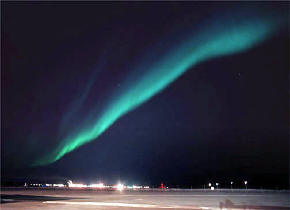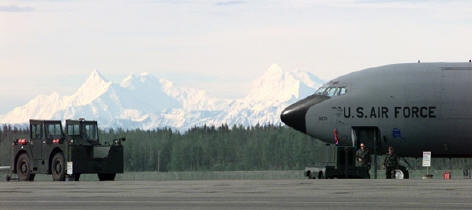| SAC Bases:
26 Mile Post / Eielson
Air Force Base |
|
 |
 |
| Aurora Borealis over the
base |
Flight line with mountains
in the background |
|
Eielson AFB
is located 26 miles southeast of Fairbanks in central Alaska's
Fairbanks-North Star Borough. Fairbanks is Alaska's second largest city
with approximately 32,000 residents; the entire Fairbanks-North Star
Borough contains approximately 75,000 people. North Pole is the nearest
community to the base, located nine miles away and having approximately
1,500 residents.
Because of its strategic location, Eielson played an
important role in SAC's planning. Over the years, tanker squadrons
and other units have been assigned to the base.
The 97th Bomb
Wing was assigned to SAC by November 30, 1946. From Kansas, it
deployed to Mile 26 Air Field (later Eielson AFB), Alaska. It's crews
flew their B-29s over the Arctic Ocean on Training Missions. In
accordance with the new Air Force Wing Organization Plan, it was
established as the 97th Bombardment Wing, Very Heavy, on December 1,
1947. It was then assigned to 15th Air Force, attached to the
Yukon Sector of the Alaskan Air Command.
On March of 1948, it joined the newly attached 8th Air Force. The
wing moved to Smoky Hill AFB, Kansas and was attached to the 301st Bomb
Wing for three months additional training.
The next wing to call Eielson its home was the
4157th Strategic Wing. From 1962 to 1967. It flew KC-135s and
RC-135s. It was replaced by the 6th Strategic Reconnaissance Wing
which flew from KC-135s and RC-135s from 1962 to 1992. |
Ladd Field
Ladd Field, now Fort Wainwright, was
created in 1939 primarily as a site for cold-weather testing of aircraft
and equipment. Only Interior Alaska offered the consistently cold
temperatures needed. The attack on Pearl Harbor in December
1941, forced the temporary halt on testing at Ladd since the military
needed all aircraft for the defense of Alaska. Testing resumed
less than a year later. Along with testing aircraft, the military also
tested clothing, equipment and other materials.
By 1943 testing had become a second priority. Ladd had
found itself a busy hub for fighters and bombers destined for the
"Forgotten 1,000 Mile War" in the Aleutians or en route to Soviet forces
as part of the Lend-Lease Program. Ladd was the turn-over
point for large numbers of aircraft and pilots who made the arduous trip
from Montana through the Northwest Territories into the Interior.
In August and September 1942, the first Soviet pilots and civilians of
the Soviet Purchasing Commission arrived in Fairbanks and were housed at
Ladd Field. There they checked out in aircraft ranging from P-39 Air
Cobras to B-25 Mitchell bombers. The first lend-lease flight took
place Sept. 3, 1942, and these flights continued through August 1945. In
all nearly 8,000 aircraft passed through Alaska, were turned over to the
Russians and ferried over the "air bridge." The aircraft
were completely stripped of everything except basic instrumentation and
armament. With no navigational aids, flights would take off from Ladd
Field and fly the first leg to Galena on the Yukon River.
Mile 26
Many of the airplanes were sometimes unable to make it to Ladd. And many
of the aircraft didn't have enough fuel to make it back to an alternate
base. The military decided to build an auxiliary field somewhere
close but south of Ladd Field so it could be used as a
weather-alternate. Those chose the site where Eielson sits today
for good reasons. The government already owned the land and the
surrounding terrain was free of approach hazards for the arriving
aircraft. The nearest hills, low ones at that, were approximately six
miles from base.
The base was dubbed "Satellite" or "Mile 26" by some workers
and "26-Mile Strip" by the brass. One story had it the base was named
26-Mile Strip because of its proximity to one of the 13 Army telegraph
stations that linked Fairbanks with Valdez as part of the Army's
Washington-Alaska Military Communications and Telegraph, system.
Another account states that the name was the result of the field being
located exactly 26 miles from Fairbanks.
The Cold War
In 1946, with the onset of the Cold War, there was need
for a large bomber base. Ladd was ruled out because its main
runway had already been extended from its original 5,000 feet to 9,200
feet and now was bounded by river banks. The army chose a site for
the new base 29 miles south of Nenana. The area was surveyed, the
runway was laid out at 14,500 feet long, the railroad siding was
constructed, two temporary warehouses were built and two wells were
drilled. Then there was a series of earthquakes that revealed a
fault running across the center of the runway. All the funds
left from the aborted construction near Nenana were transferred to
26-Mile Strip, and the expansion began. The existing west runway was
expanded to the same length of the runway south of Nenana - 14,500 feet
long, That was not the last of the site south of Nenana, though. A
year later the military began awarding contracts for constructing
defense early warning radar and communication installations throughout
the state. Since the 16,000 acres had already been withdrawn, the
military decided to go ahead with the construction of Clear Air Force
Station, which remains today.
The Air Force is created
On Sept. 18, 1947, the Air Force gained its
independence from the Army as a separate branch with President Truman's
signing of the National Security Act of 1947. The newly created Air
Force now had two bases near Fairbanks. Ladd Field was home to
fighter-interceptors providing air defense in the Interior, and in
November the first Strategic Air Command bombers arrived at 26-Mile with
the deployment of the 97th Bomber Group from Smokey Hill Air Force Base,
Kan. Shortly afterward, on Feb. 4, 1948, the Air Force changed the name
of 26-Mile Post to Eielson Air Force Base in honor of famed Arctic
aviation pioneer Carl Ben Eielson.
The transfer of Ladd Field
The 97th Bomber Group departed Eielson in March 1948,
but other Strategic Air Command units followed. Eielson played host to
B-29s, B-36s and finally B-47s. In fact, the largest hangar on Eielson
today, now used for the Air Force's Cope Thunder exercises, was
originally built to house two B-36 "Peacekeeper" bombers, the largest
bomber ever in Air Force inventory.
During these years, the Air Force had mixed emotions
about having two air bases - Ladd and Eielson - so close together.
After the Korean War, the Air Force began to look at ways to cut costs.
The Air Force decided to transfer Ladd to the Army and move its
operations to Eielson. On. Jan. 1, 1961, Ladd Field was returned
to the Army and became Fort Wainwright.
The future
The Air Force has seen many changes at Eielson, and
many missions and aircraft have come and gone. Since its early days,
Eielson has also been home to weather reconnaissance aircraft, tactical
units from Alaskan Air Command, aerial tankers and, most recently,
F-16s, A-10s and OA-10s as part of the 354th Fighter Wing, flying close
air support and forward air control missions for nearby ground units.
Strategically, Eielson's location allows units based here to respond to
hot spots in Europe faster than units at bases on the East Coast. The
same is true for Korea and the Far East. Eielson units can respond
quicker than many of the units based in California.
Eielson also has an important mission thanks to its
close working relationship with the Army in Alaska - specifically, the
6th Infantry Division (Light) at Forts Wainwright, Greely and
Richardson. A 1940 census reported that 1,000 military people lived in
Alaska that year. Today, Eielson alone has almost three times that
number of military people.
The military in Alaska has roughly 24,000
active-duty people in the state, helping to explain why its $1.5 billion
in spending annually ranks second only to the oil industry. And with
Alaska's strategic location, recognized in the 1920s and 1930s by Air
Force pioneers like Generals Henry "Hap" Arnold and Billy Mitchell - the
vision of Eielson's future certainly outshines its humble beginnings,
and may someday outshine its historic past. "Alaska is the most central
place in the world for aircraft, and that is true of Europe, Asia or
North America. I believe in the future, he who holds Alaska will hold
the world, and I think it is the most strategic place in the world." -
Brig. Gen. Billy Mitchell appearing before House Committee on Military
Affairs in early 1935, which was holding hearings regarding the
strategic needs of the fledgling U.S. Army Air Corps and the
establishment of new bases for frontier defense. |
|
|
|
